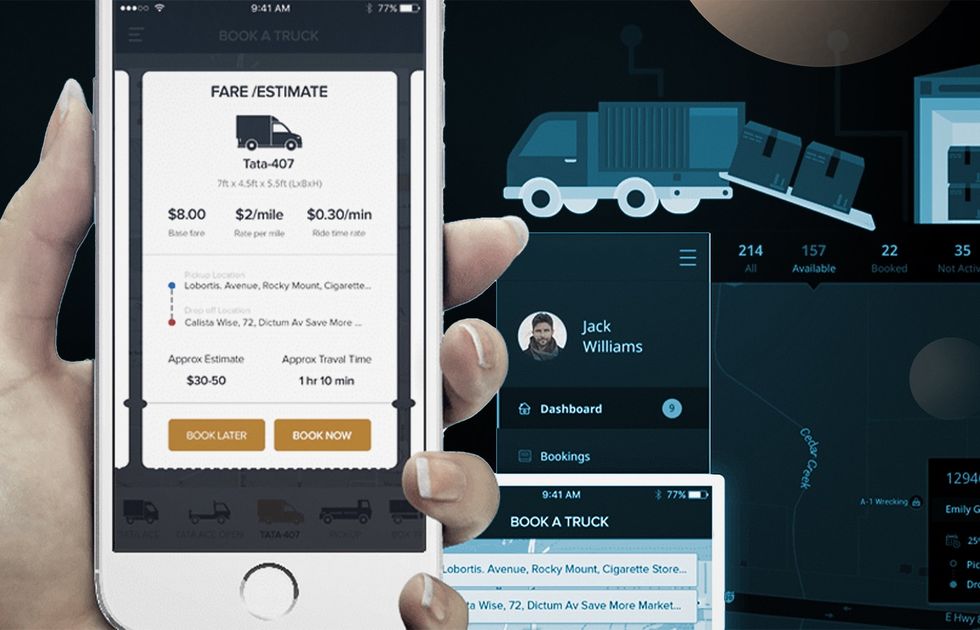Trucking dispatch software enhances customer service and retention by streamlining operations and communication. It allows trucking companies to efficiently manage deliveries, which improves client satisfaction and loyalty.
In the competitive trucking industry, providing exceptional customer service is key to maintaining a loyal customer base and driving business growth. Trucking dispatch software plays a pivotal role in this by optimizing dispatching procedures, tracking shipments in real-time, and ensuring timely deliveries.
By incorporating advanced technology to manage logistics, trucking businesses can address customer needs more effectively and reduce response times for service requests. This, in turn, not only retains existing clients but also attracts new ones through positive reviews and word-of-mouth referrals. Companies leveraging such software are better equipped to handle the dynamic demands of freight management, making them more reliable and customer-focused in the eyes of their clients.
Challenges In Traditional Trucking Dispatch
In the competitive world of logistics, trucking companies continuously strive to offer exceptional customer service while streamlining their operations. However, traditional trucking dispatch methods often pose numerous challenges that can impede efficiency and hinder customer retention. Understanding these limitations is crucial for companies looking to modernize their approach and maintain an edge in the ever-evolving transportation industry.
Discuss The Limitations Of The Traditional Dispatch Methods
Traditional trucking dispatch practices are known for their manual and time-intensive processes. Dispatchers have long relied on paper-based systems and phone calls to manage their fleets, leading to several limitations:
- Errors and inaccuracies due to manual data entry
- Delayed communication when managing dispatch changes
- Difficulty in tracking driver availability and assigning loads efficiently
- Challenges in adapting quickly to unexpected changes or emergencies
Lack Of Real-time Visibility
Without the aid of modern technology, traditional dispatch systems fall short in providing real-time visibility of fleet operations. This limitation can lead to several issues:
- Inability to monitor the exact location of vehicles and drivers
- Difficulty in providing customers with accurate delivery updates
- Potential loss of goods or delays due to lack of oversight
- Impaired decision-making as a result of outdated information
Inefficient Scheduling And Routing
The traditional means of scheduling and routing often result in inefficiencies due to the absence of dynamic planning tools. This can manifest in various ways:
- Increased fuel consumption from suboptimal routing
- Higher operational costs due to poorly planned schedules
- Missed opportunities for consolidating loads and reducing empty miles
- Driver dissatisfaction from unrealistic or inefficient job allocations
These challenges are telling; they underscore the need for innovation and adoption of trucking dispatch software to improve customer service and increase retention rates. By leveraging modern solutions, trucking companies can overcome the hurdles of traditional dispatch methods and propel their businesses into a more productive and profitable future.
Leveraging Trucking Dispatch Software
Welcome to the pivotal discussion on how trucking dispatch software holds the key to elevating customer service and nurturing client retention within the logistics industry. Recognizing the importance of innovation in trucking dispatch is essential for businesses aiming to streamline operations and enhance overall service delivery. Let’s delve into the far-reaching impacts of harnessing the power of modern dispatch software.
Emphasize The Benefits Of Using Trucking Dispatch Software
Implementing trucking dispatch software offers a myriad of advantages that can transform the way logistics companies operate. From improving communication channels to increasing the efficiency of dispatch processes, the software is a vital tool for businesses targeting success.
- Streamlined Operations: The coordination between dispatchers and drivers becomes seamless, reducing errors and saving valuable time.
- Enhanced Customer Satisfaction: With improved reliability and punctuality, customer satisfaction levels soar, which in turn promotes customer loyalty.
- Cost-Effectiveness: Operating costs are minimized as the software aids in finding the most economical routes and managing resources well.
- Data-Driven Decisions: Access to real-time data and analytics helps businesses make informed decisions that align with ongoing trends and operational requirements.
Real-time Tracking And Monitoring
Real-time tracking enabled by dispatch software delivers critical insights into fleet operations: where trucks are currently located, their movement trajectory, and the status of deliveries. This level of monitoring not only boosts security but also enables proactive management of any on-route issues.
- Immediate Updates: Customers enjoy instant updates on delivery timelines, enhancing transparency and trust between clients and service providers.
- Operational Oversight: Fleet managers maintain comprehensive oversight over assets, enabling quick response to any deviations from the planned schedules.
Automated Scheduling And Route Optimization
One of the standout features of dispatch software is its ability to automate scheduling and optimize routing for deliveries. The implementation of this technology leads to noteworthy improvements in efficiency and resource usage.
- Scheduling Efficiency: Flight delays and human errors can be mitigated as the system generates the most effective schedules based on numerous variables.
- Dynamic Routing: Routes are optimized not just for distance but also taking into account traffic patterns, weather conditions, and delivery time windows, ensuring timeliness and fuel economy.
Key Features For Customer Service Improvement
Customer service remains a pivotal point of competition among trucking companies, and leveraging technology to excel in this realm is becoming increasingly important. Trucking dispatch software is designed not only for operational efficiency but also to enhance customer engagement and satisfaction. The following sections will highlight some key features that are vital for customer service improvement in the world of trucking dispatch.
Integrated Communication Tools
Efficient communication channels are the backbone of any customer service strategy. Trucking dispatch software with integrated communication tools allows for seamless interaction between dispatchers, drivers, and customers. Users can expect features such as:
- Real-time messaging between drivers and dispatchers, enabling instant support and updates.
- Customizable email and SMS templates for consistent communication.
- Automated alerts to keep all parties informed about load status changes.
- Centralized information hubs for quick access to communication histories.
On-time Delivery Notifications
Customers appreciate knowing the status of their shipments without the need to reach out manually. With trucking dispatch software, on-time delivery notifications are a game-changer. This feature provides:
- Automatic notifications to customers upon cargo departure and arrival estimations.
- Live tracking capabilities giving customers the visibility they desire.
- Enhanced reliability with real-time updates in case of unexpected delays.
- Proactive management of delivery expectations, reducing uncertainty and building trust.
Enhancing Customer Retention Strategies
In the competitive landscape of the trucking industry, where every client counts, enhancing your customer retention strategies is paramount. Strategic use of trucking dispatch software not only simplifies operations but also solidifies relationships with clients. Here’s how sophisticated dispatch tools are the key to keeping customers on board and satisfied.
Discuss How Trucking Dispatch Software Can Assist In Customer Retention
Trucking dispatch software is more than just an organizational tool; it’s a retention powerhouse. By streamlining communication and delivery processes, it ensures that services are prompt and reliable. Customers favor companies that can consistently provide them with hassle-free experiences, and a robust dispatch solution facilitates exactly that. This software aids in:
- Maintaining accurate records of customer preferences and history
- Providing real-time updates and ETA’s to customers
- Fostering transparency through digital proof of delivery
- Offering quick and efficient resolution to queries with integrated customer support features
Personalized Customer Service
With the right dispatch software, customization is at your fingertips. This technology allows for personalized service, showing clients they are more than just a number. Examples include:
- Storing specific customer requirements or delivery instructions
- Customizing communication templates for order confirmations, updates, and more
- Segmenting customers based on service usage for more targeted service offerings
Data-driven Performance Analysis And Improvement
Data is a gold mine for any business, and trucking companies are no exception. By leveraging historical and real-time data, trucking dispatch software allows for in-depth analysis of on-the-ground operations. This in turn enables performance optimization with strategies such as:
- Identifying trends in service demands to better allocate resources
- Evaluating driver performance for training or incentivization
- Measuring customer satisfaction through feedback and ratings

Credit: www.detrack.com
Frequently Asked Questions On Improving Customer Service And Retention With Trucking Dispatch Software
How Do Truck Dispatchers Get Clients?
Truck dispatchers get clients by networking, making cold calls, enhancing their online presence, seeking referrals, partnering with delivery businesses, using load boards, targeting specific markets, and offering competitive rates.
What Is Trucking Dispatch Software?
Trucking dispatch software is a digital tool that manages load scheduling, delivery tracking, and dispatch operations for trucking companies.
How Can I Be A Better Truck Dispatcher?
To be a better truck dispatcher, develop strong communication skills, know your drivers and fleet capabilities, and leverage dispatch software. Continually learn industry best practices while adapting to new technologies and maintaining a problem-solving mindset. Prioritize efficient route planning and provide exceptional customer service.
How Can I Be An Efficient Dispatcher?
To be an efficient dispatcher, prioritize clear communication, embrace technology for scheduling and tracking, remain calm under pressure, learn effective route planning, and continuously seek feedback for improvement.
Conclusion
Embracing trucking dispatch software elevates service quality and bolsters customer loyalty. It streamlines operations and enhances communication. Adopting these tools can significantly boost your company’s competitive edge and client satisfaction. Let this technology take your customer service and retention to new heights.
Implementing smart dispatch solutions is the forward stride in trucking excellence.
- The Power of Mobile Accessibility And Real-Time Tracking for Trucking Operations - November 6, 2024
- Why Ease of Use is Crucial in Trucking Dispatch Software - September 22, 2024
- Better Communication With Dispatchers: How Trucking Dispatch Software Can Optimize Operations - September 7, 2024


